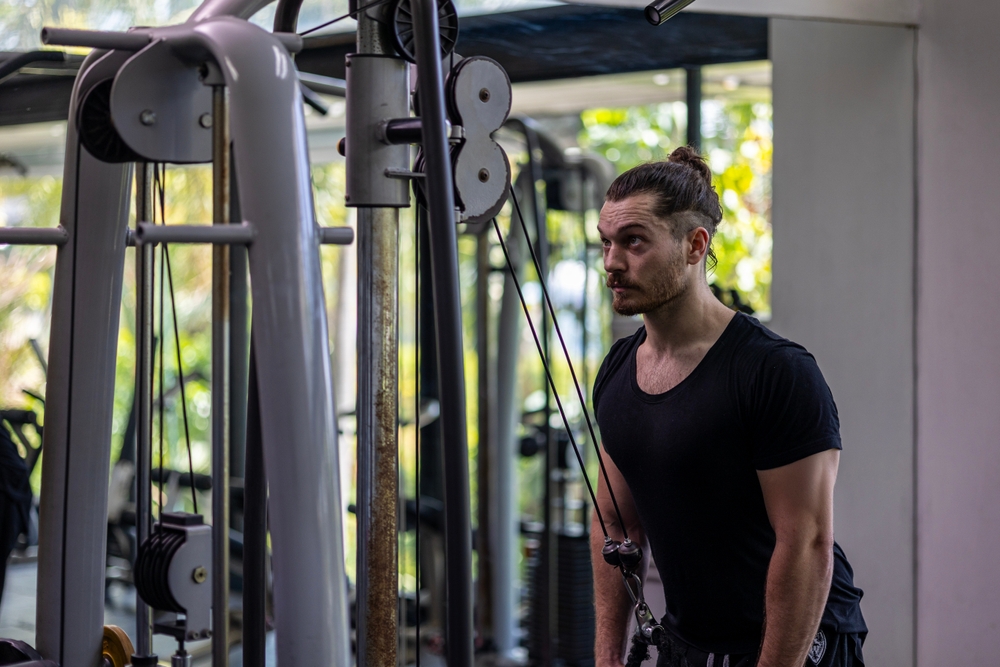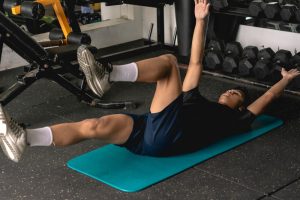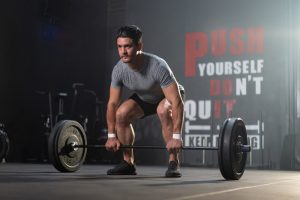The triceps pull—also known as the triceps pushdown—is done correctly by keeping your elbows pinned to your sides and moving only at the elbows while using a full range of motion with controlled reps.
This approach keeps tension on the triceps, prevents momentum, and leads to better arm growth.
Keep reading for a detailed breakdown of proper setup, execution, variations, and programming tips to maximize your results.
Understanding the Triceps Pushdown: What It Targets and Why It Works
To get the most out of the triceps pushdown, it's helpful to understand what muscles you're actually working and why this movement is such a mainstay in effective arm training.
The pushdown isn’t just another cable exercise—it directly targets key parts of the triceps and plays a smart role in a well-rounded program.
The Three Parts of Your Triceps — And Which Ones You're Hitting
Your triceps muscle has three distinct parts: the long head, lateral head, and medial head.
These work together to extend the elbow, but each one contributes differently depending on the exercise and arm position.
During a standard pushdown—whether with a rope or straight bar—your elbows stay pinned at your sides and your arms move downward in a fixed path.
This position limits how much the long head can contribute, making the pushdown especially effective at targeting the lateral and medial heads.
These are the heads that give your arms that distinct horseshoe shape, especially when viewed from the side.
The lateral head is more active when you use an overhand grip and push with force, which is exactly what happens in the pushdown.
Meanwhile, the medial head helps stabilize and finishes the movement, especially as you approach full extension.
So while you’re not isolating any one part completely, the movement naturally emphasizes these two areas the most.
Elbow Extension: The Key Movement Behind It All
At its core, the triceps pushdown is all about elbow extension.
That’s the primary function of the triceps—straightening your arm from a bent position.
And because the movement keeps your shoulders and upper arms still, it puts all the focus on the elbows doing the work.
That’s also why keeping your elbows pinned and not letting your shoulders take over is so critical.
If you start shifting your torso or letting your upper arms move, you’re reducing the workload on the triceps and letting other muscles sneak in.
Why the Pushdown Is So Widely Used
There’s a reason this movement shows up in nearly every training plan:
- Controlled, joint-friendly mechanics – The cable setup provides a smooth resistance curve and doesn’t stress your joints like some free-weight exercises can.
- Low risk of injury – It’s a very stable movement with minimal technical complexity, making it safe for all experience levels.
- Easy to scale – You can increase reps, weight, or add advanced variations like rope flares or drag-style pushdowns.
- Highly repeatable – You can perform pushdowns frequently without overloading your central nervous system or risking form breakdown.
Unlike heavy compound lifts that tax multiple systems, the pushdown allows you to target the triceps directly, cleanly, and consistently.
Where It Fits in an Arm-Building Plan
Think of the pushdown as your go-to movement for focused triceps work, especially for bringing out shape and definition.
But it doesn’t cover everything.
The long head of the triceps, which gives your upper arm mass and fullness from the back, is only fully stretched and recruited when your arms are overhead.
That’s where overhead extensions and movements like skull crushers come in—they complement pushdowns by filling in that missing piece.
So in a complete program, pushdowns often act as the primary driver for volume and shape, while overhead movements handle stretch-based mechanical tension, which research shows is key for muscle growth.
When combined, these approaches hit all three heads and ensure your arms develop fully, not just from one angle.
The pushdown may look simple, but when done correctly and programmed smartly, it’s one of the most valuable tools for building stronger, better-looking arms.
Setup and Body Position: Laying the Foundation for Proper Execution
Getting the setup right is more than just comfort—it’s the difference between building your triceps efficiently and wasting reps with poor form.
A strong starting position keeps tension exactly where you want it and makes every rep count.
Start by attaching the cable pulley to a high anchor point.
This gives you a full range of motion to work through and ensures constant resistance from top to bottom.
Most setups come with a variety of attachments, but both the straight bar and rope handle are effective.
The choice depends on your training focus—rope handles allow more freedom at the bottom, especially when flaring, while the straight bar offers a more rigid, controlled path.
Either works well, so it often comes down to feel and preference.
Next, position yourself about an arm’s length away from the machine.
This distance matters more than people realize. If you’re too close, you lose tension at the top of the movement, especially as your arms start to bend.
Standing too far back, on the other hand, encourages leaning or using your body weight, which takes the focus off your triceps.
The goal is to maintain a natural, vertical path for the cable while keeping your upper arms still.
Your stance sets the base for everything above the waist.
A shoulder-width stance works for most people, giving you enough balance without restricting movement.
If you tend to shift or lean, try a staggered stance—placing one foot slightly behind the other—for added stability, especially on heavier sets.
As you settle into position, lean slightly forward at the hips—not the waist.
This subtle hinge creates the right body angle to push straight down without engaging your shoulders or compensating with momentum.
Just make sure your back stays flat, not rounded.
Engage your core to stay locked in, especially during heavier sets, when it’s easy to sway without realizing it.
Before starting the movement, bring your elbows to your sides and keep them pinned there.
Your forearms should form roughly a 90-degree angle with your upper arms.
This is your starting point.
From here, you’ll press straight down using only your elbows—not your shoulders, not your back, just that single joint doing the work.
These positioning cues might seem minor, but they directly impact how much of the load your triceps carry.
Getting into the right setup once makes it easier to stay consistent across sets and over time—and consistency is where real progress comes from.
Execution Breakdown: Step-by-Step Guide to a Perfect Rep
Once you’re in position, every part of the movement should feel intentional.
Triceps pushdowns might look simple, but the way you perform each rep determines whether you're building muscle or just moving weight.
Start with a firm overhand grip on the bar or rope.
This grip keeps your wrists in a neutral position, which not only feels more comfortable but also supports better triceps engagement.
Before you initiate the movement, retract your shoulders slightly—think of pulling them down and back.
This small adjustment helps take the delts out of the equation and creates a stable upper-body frame to work from.
As you begin the rep, drive the attachment downward by extending only at the elbows.
The rest of your body—shoulders, torso, hips—should stay completely still.
No leaning, no rocking, no swinging. Your elbows should stay locked into place at your sides, moving like hinges.
Don’t rush the bottom of the movement. As you near full extension, stop just shy of locking out your elbows.
Going to a full lockout can take tension off the muscle and potentially strain your joints, especially under heavier loads.
Instead, aim for a strong contraction just before lockout to keep constant tension on the triceps.
At the bottom of the rep, pause briefly and squeeze.
If you’re using a rope attachment, this is where you can flare the ends apart to really activate the lateral head.
That small outward movement creates a peak contraction you can’t get with a bar.
Hold that squeeze for a second—it’s not about how fast you can get through the rep, but how well you control it.
Then comes the return. Slowly let the weight come back up, following the same path in reverse.
This is where most people lose focus. But the eccentric, or lowering phase, is just as important for muscle growth—if not more.
Stop just above a 90-degree elbow angle to reset for your next rep without resting at the top.
Done correctly, each pushdown rep should feel like a clean, powerful arc with full control from start to finish.
The rep tempo doesn’t have to be overly slow, but it should never feel rushed or sloppy.
If your form breaks down at any point—especially if your torso starts to move—it’s a sign you’re either going too heavy or not bracing correctly.
Focus on mastering this clean rep pattern first.
Everything else—progressive overload, intensity techniques, and variation—only works when your baseline execution is dialed in.
Form Cues and Common Mistakes to Avoid

Even with a good setup and solid understanding of the movement, small errors in form can quickly add up and reduce the effectiveness of your triceps pushdowns.
Worse, they can shift tension away from the muscle you’re trying to target—making your efforts less productive.
Here’s what to look for and how to fix it.
The most common mistake is letting your elbows drift forward or outward as you press down.
Your elbows should stay pinned to your ribcage throughout the entire movement.
If they start to float forward or flare out to the sides, the triceps lose tension and the shoulders begin to take over.
This not only shortchanges your reps but also creates unwanted movement patterns that can lead to long-term imbalance.
Closely related is the habit of using your shoulders or torso to generate force—especially when fatigue kicks in or the weight is too heavy.
You might find yourself leaning back slightly or swinging the upper body to “help” move the weight.
But remember, the triceps pushdown is a single-joint movement.
The only joint that should be moving is your elbow.
If anything else is shifting, it’s time to reset your form or reduce the load.
Your position relative to the machine also matters more than most people think.
Standing too close to the pulley shortens the cable path and reduces the stretch on your triceps at the top of the rep.
It might feel more comfortable, but it limits the range of motion and reduces tension where it counts.
Step back slightly—roughly an arm’s length from the pulley—to keep the resistance curve working in your favor.
Another issue is chasing heavy weight at the expense of execution.
Triceps respond better to moderate loads with high control, not sloppy reps powered by momentum.
Going too heavy usually means you’ll cut the range short, rush the reps, or let your form break down in subtle but impactful ways.
To make every rep more effective, focus on time under tension.
This means slowing down the eccentric (lowering) phase and eliminating any jerky movements.
A controlled rep tempo doesn’t just protect your joints—it keeps the muscle working harder for longer, which is a key trigger for hypertrophy.
In short, pushdowns should feel clean and isolated.
If you’re unsure whether your form is solid, try filming yourself or performing a few reps with very light weight.
Pay close attention to your elbow position, torso stillness, and range of motion.
These fine details might seem small in the moment, but they’re what separate effective training from just going through the motions.
Effective Variations and When to Use Them
Once you’ve mastered the standard pushdown, mixing in variations can help round out your triceps development and keep your training fresh.
Each version places slightly different demands on your muscle fibers, making them valuable tools for targeting all three heads of the triceps—especially the long head, which isn’t as active in the traditional pushdown.
Rope pushdowns are one of the most accessible and effective alternatives.
Unlike the straight bar, the rope allows your hands to separate at the bottom of the rep.
That outward flare increases lateral head activation and lets you contract the triceps more forcefully.
The movement also adds a bit more freedom at the wrist, which can be more comfortable for some lifters.
If you're looking for a way to get more squeeze at the bottom, this should be your go-to variation.
Drag pushdowns shift the emphasis to the long head of the triceps by changing your elbow position.
Instead of keeping your elbows directly at your sides, you intentionally keep them slightly behind your body as you press down.
This altered arm path recruits the long head more aggressively and creates a strong contraction at the bottom.
It’s a subtle adjustment, but one that delivers a noticeably different training stimulus.
Then there are overhead rope extensions, which are especially valuable because they place the long head of the triceps under stretch—something the standard pushdown can’t do.
When your elbows are overhead, the long head is fully lengthened at the start of each rep.
This setup has been shown to promote more muscle growth due to the increased mechanical tension created in the stretched position.
It works well as a second movement after pushdowns, giving your triceps a different kind of stress to adapt to.
If you train at home or want to use free weights, skull crushers are a strong alternative to overhead rope extensions.
They similarly emphasize the long head through a stretched range of motion, though they require more control and proper positioning to avoid elbow or wrist strain.
A flat or slightly declined bench often works best to keep tension consistent throughout the movement.
To make the most of these variations, alternate them across your training weeks.
One option is to use rope pushdowns or straight bar pushdowns as your main triceps movement, then follow with a long-head-focused exercise like overhead rope extensions or skull crushers.
You can also rotate between variations every 3–4 weeks to prevent plateaus and keep stimulus balanced.
Programming for Growth: Sets, Reps, and Progression Tips
Building bigger triceps doesn’t happen by chance—it requires structured, consistent programming.
You need the right mix of volume, intensity, and movement variety to challenge the muscle from different angles without compromising form or recovery.
Start by treating triceps pushdowns as your primary movement.
These are ideal for beginning your arm workout because they’re joint-friendly and allow you to warm up the elbows with high control.
For most lifters, 3 to 4 sets of 8 to 15 reps works well.
Staying in this rep range gives you enough time under tension to drive hypertrophy, while also letting you use enough weight to create meaningful resistance.
To cover what pushdowns miss, particularly the long head of the triceps, add a second movement with your arms positioned overhead.
This could be overhead rope extensions on a cable setup or skull crushers with dumbbells or an EZ-bar.
Aim for 2 to 3 sets of 10 to 12 reps here.
The slightly higher rep range supports joint health and gives you the chance to focus on control in the stretched position.
Regardless of the variation, it’s important to use moderate weights—heavy enough to challenge you, but not so much that you’re compromising range of motion or recruiting other muscles to get the job done.
When in doubt, choose a load that allows clean, smooth movement across every rep.
If your form breaks by the eighth rep, the weight is too heavy for hypertrophy work.
Progressive overload is what drives long-term gains. That doesn’t mean piling on more weight every week, though.
Instead, track your reps and sets, and look for small improvements over time.
If you performed 3 sets of 10 last week, aim for 11 or 12 this week with the same weight.
If you hit the upper end of your rep range across all sets with good form, consider increasing the weight slightly the next session.
Finally, for well-rounded development, make sure you’re combining pushdowns with an overhead movement regularly.
Pushdowns hit the lateral and medial heads effectively, but the long head needs overhead work to grow.
Programming both within your training week—or even within the same workout—ensures all three heads get the attention they need.
This balanced, progressive structure isn’t just about building mass—it also helps you develop stronger, more durable arms that perform better across all upper-body lifts.
Stick to the basics, keep your form sharp, and make steady progress week by week.
That’s the formula that works.
Conclusion
The triceps pushdown is a simple yet highly effective movement—when done correctly.
By focusing on strict form, using full range of motion, and incorporating smart variations, you can target all three heads of the triceps for balanced growth.
Stay consistent, progress gradually, and pair pushdowns with overhead work to build stronger, fuller arms.







